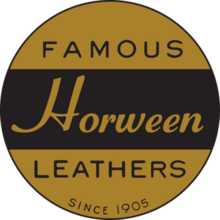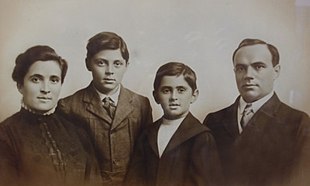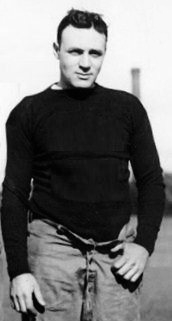 | |
| Company type | Private |
|---|---|
| Industry | Leather tannery |
| Founded | Chicago, Illinois (1905; 119 years ago (1905)) |
| Founder | Isadore Horween |
| Headquarters | 2015 North Elston Avenue, Chicago, Illinois, United States |
| Revenue | $25 million (2012) |
| Number of employees | 160 (2012) |
| Website | www |
Horween Leather Company is an American company specializing in the manufacturing and refining of leather and related products. It is one of the oldest continuously running tanneries in the United States. Since its founding in the early 20th century it has been located in Chicago.
Isadore Horween founded the company in 1905, and worked in it until 1949. His two sons, Arnold Horween (chairman and president; 1949–1984) and Ralph Horween, became executives of the company and worked in it after their careers as All American football players for the Harvard Crimson, and playing in the National Football League.
Arnold's son Arnold Horween Jr. worked with it from 1953 to 2003, and his son Arnold "Skip" Horween III has worked with it since 1972. The fifth generation of Horweens, Nicholas (Nick) Arnold Horween, has worked at the company since 2009.
Horween Leather Company offers an array of tannages using primarily cowhide and horsehide, and also using smaller quantities of calf and bison hides. Its leather is used in a number of products including sports equipment, sports and casual footwear, bags, wallets, briefcases, belts, coats, jackets, and other apparel and accessories. It is known for its production of Shell Cordovan (the Chicago Tribune called it the "Cordovan capital of the world"), professional football leather, and Chromexcel, among other leathers. It is the exclusive supplier of leather for National Football League footballs, and also supplies the leather that is used for National Basketball Association basketballs.
Horween Leather Company is located in a five-story block-long factory at 2015 North Elston Avenue, at Ashland Avenue near the Chicago River.
History
1905–1948

Isadore Horween (whose surname was originally Horwitz or Horowitz), who had learned the leather business in his native Ukraine, lived just outside Kiev, immigrated to the United States in 1893. He obtained his first job at a tannery in the U.S. through a contact he made at the 1893 World’s Columbian Exposition in Chicago. For 12 years he worked in one of the then-two-dozen tanneries in Chicago.
He founded I. Horween and Co. in 1905, and established it on Division Street in Chicago. At the time, Chicago was a major center of the meatpacking industry and a major rail hub. The tanneries were built close to the source of raw materials. In 1911, Isadore Horween developed and produced Aniline Chromexcel, one of the company's most traditional tannages.
The company's original focus was the production of razor strops, to sharpen razors used in shaving. With the advent of the safety razor in 1912, however, the need for razor strops waned, and the company shifted its focus to other products.
In 1920, the company moved to its current location in a five-story block-long factory at 2015 North Elston Avenue (at Ashland Avenue), on the Chicago River, in Chicago's Bucktown, on the north side of the city. Isadore Horween had obtained the site, which remains the company's current location, by purchasing it from Herman Loescher and Sons tannery. The company's name was eventually changed to Horween Leather Company.

In 1921, the company's secretary and treasurer was Isadore's son Ralph Horween, during Ralph's career as a football player for the Harvard Crimson and before his career as a player and coach in the National Football League. In 1945, he was still secretary of the company.
In 1927, Horween Leather Company sold the tannery on Division Street, and consolidated its operations at North Elston Avenue. In 1930, it developed mechanical leather, a very durable heavyweight leather for use in oil seals, gaskets, and engine seals. In 1936, the company had 336 workers.
In 1938, Horween Leather Company became the official leather supplier for U.S. Marine Corps water-resistant footwear during World War II. It supplied Chromoexcel, which was used exclusively in the North African Campaign. In 1941, it added a large addition to the tannery.
1949–1984
Isadore's son Arnold Horween eventually took over the company business, after his career as a football player at Harvard alongside his brother Ralph, and then again with his brother as player-coaches in the National Football League, and finally as Harvard's head football coach. He ran the company as chairman and President, from 1949 to 1984.
In 1960, the company developed and offered football leather as it is made and sold today. In 1978 there were 250 tanneries in the U.S., but by 2005 the number had dropped to approximately 20.
1985–present
In 1985, Arnold Jr., Isadore's grandson, succeeded his father as Horween Leather Company's chief executive. In 1990, the company developed and offered waterproof lines of leathers.
Arnold, Jr.'s son Arnold "Skip" Horween III, Isadore's great-grandson, joined as treasurer that year, and became vice president in 1995. In 2001, Skip Horween took over running the company, and in 2002 he became president. The company is now run by the fourth generation, with the fifth generation also in house.
In 2003, the company began supplying leather for the Arena Football League. In 2005, the company had sales of over $35 million. In 2006, it became the only tannery in Chicago; at one time, the city had as many as 40.
As of 2012, Horween Leather Company had 160 employees, and annual revenues of approximately $25 million. In a typical week, it processes 4,000 cowhides and 1,000 horsehides into 120,000 square feet (11,000 m) of leather. As of 2013, Horween Leather Company was one of fewer than a dozen tanneries in the U.S., down from over 250 in 1978.
The Horween family
The following reflects each generation of the Horween family that worked in the company:
- Isadore Horween, 1905–1949
- Arnold Horween, 1922–1984 (Chairman & President 1949–1984)
- Arnold Horween Jr., 1953–2003
- Arnold (Skip) Horween III, 1972–present
- Nicholas (Nick) Arnold Horween, 2009–present
The tanning process
About 85% of the leather at Horween Leather Company is made from cowhide. The company's workers take raw hides, which arrive salted to prevent deterioration, trim them, and remove their hair with chemicals in an extremely large washing drum. The leather is then treated with salt and pickled for 24 hours, so that it reaches a desired pH level. It is then bated, tanned, and finished.
Products
Horween Leather Company produces many different full grain and corrected grain leathers. Its leather is used in a number of products including footwear, sports equipment, bags, belts, wallets, briefcases, suitcases, jackets, coats, and other apparel and accessories. As of 2003, 60% of the company's leather was used to make clothes, shoes, and accessories, and 40% for sporting goods such as footballs, basketballs, and baseball gloves.
Horween Leather Company supplies leather shells for footwear to the Timberland Company, Alden Shoe Company (their largest cordovan customer; it became a customer in 1930, buying shell cordovan and other leathers), Cole Haan, Allen Edmonds, Nomad Goods, Brooks Brothers, Hanover Shoe, Chippewa Boots and Johnston & Murphy. Accessories and leather goods customers include J.Crew and Shinola Detroit.
Sporting goods


Horween Leather Company has provided Rawlings with leather since 1929. In 2003, Horween was providing leather for 3,000 Rawlings baseball gloves annually, and half of professional baseball players were using baseball gloves made from Horween leather.
Wilson Sporting Goods is Horween Leather Company's largest customer, using the company's leather in manufacturing footballs and basketballs. Horween Leather Company has supplied Wilson with pebbled cowhide since 1941.
Since 1941, Horween Leather Company has been the exclusive supplier of leather for National Football League footballs. The arrangement was established initially by Arnold Horween, who had played and coached in the NFL. The company uses its own "Tanned in Tack" process. Although footballs are often called "pigskins," they are made from Horween Leather Company-supplied steer hides that are embossed with a pebble pattern. The company also supplies the leather for the game balls made for the Canadian Football League, and they also supply leather to Spalding (a division of Russell Corporation) for indoor Arena Football League footballs. Horween Leather Company's leather is also used to make National Basketball Association basketballs, made by Spalding until 2021, and currently by Wilson Sporting Goods
Hydrogen sulfide gas release
On February 14, 1978, a driver making a delivery to Horween of a tanker truck filled with sodium hydrosulfide ignored signs and approached the wrong storage tank. When the driver was unable at first to connect the tanker's hose to the storage tank, which was designed to prevent accidental mixing, he connected his own homemade coupling and was able to begin delivering the sodium hydrosulfide. The homemade coupling was later impounded by the Chicago Police Department. The tank contained an acid chrome tanning liquor, and the resulting mixture immediately created a large amount of deadly hydrogen sulfide gas. Workers began collapsing as the gas spread through the building. Eight workers died and 35 were injured. The Occupational Safety and Health Administration cited the company for failing to train employees in handling dangerous chemicals or in emergency evacuation procedures.
References
- ^ Howard Wolinsky (May 16, 2008). "Horween Leather Faces an Uncertain Future". Business Week. Archived from the original on July 8, 2012. Retrieved March 26, 2013.
- ^ Schneider, Sven Raphael (March 21, 2012). "Horween Leather Company Chicago". Gentleman's Gazette. Retrieved March 27, 2013.
- ^ Tom Gavin (January 12, 2013). "Welcome to the Time Machine; Tom Gavin Visits Horween Leather Co". Haberdashmen.com. Archived from the original on May 13, 2013. Retrieved March 28, 2013.
- ^ Rolek, Barbara (October 27, 2003). "Horween's leather bound by tradition". Chicago Tribune. Archived from the original on May 13, 2013. Retrieved March 27, 2013.
- Wolinsky, Howard (May 16, 2008). "Horween Leather Faces an Uncertain Future". Business Week. Archived from the original on May 18, 2008.
- ^ Nuzum, Thomas (September 30, 1954). "'Pigskin' They're Kicking is Cow". Chicago Tribune. Archived from the original on April 11, 2013. Retrieved March 26, 2013.
- ^ Horween Leather Company. encyclopedia.com. Archived from the original on July 18, 2013. Retrieved January 20, 2016.
- ^ Arena, Stephanie (December 8, 1991). "Leather Land: At Horween Tannery, Cordovan has Been King for 86 Years". Chicago Tribune. Archived from the original on October 2, 2019. Retrieved October 1, 2019.
- Charles H. Joseph (1926). 18M. The Jewish Criterion. Archived from the original on December 13, 2013. Retrieved March 25, 2013.
- "Ralph Horween" (PDF). profootballresearchers.org. Archived from the original (PDF) on December 18, 2010. Retrieved March 25, 2013.
- Stanley Bernard Frank (1936). The Jew in sports. The Miles Publishing Company. Retrieved March 22, 2013.
- ^ Gerald R. Gems (2000). For Pride, Profit, and Patriarchy: Football and the Incorporation of American Cultural Values. Scarecrow Press. ISBN 9780810836853. Retrieved March 22, 2013.
- "Timeline « Horween Leather Company". Horween.com. Archived from the original on March 17, 2013. Retrieved March 28, 2013.
- ^ "Horween Leather Co". Mas Context. January 1, 1920. Archived from the original on January 19, 2013. Retrieved March 27, 2013.
- ^ John Maxymuk (2012). NFL Head Coaches: A Biographical Dictionary, 1920–2011. McFarland. ISBN 9780786465576. Retrieved March 26, 2013.
- ^ "A Brief History « Horween Leather Company". Horween.com. Archived from the original on July 5, 2013. Retrieved January 20, 2016.
- ^ Burgdorfer, Bob (May 3, 2007). "Passion for leather has made cowhides a hot item". Uk.reuters.com. Archived from the original on March 5, 2016. Retrieved March 26, 2013.
- UFCW Action. United Food and Commercial Workers International Union. 1992. Retrieved March 26, 2013.
- ^ "Arnold Horween". Chicago Tribune. August 7, 1985. Archived from the original on April 11, 2013. Retrieved March 26, 2013.
- The Shoe and Leather Reporter Annual. Shoe & Leather Reporter Company. 1921. Retrieved March 26, 2013.
- "Rwlb Boosts Standard Oil Workers' Pay". Chicago Tribune. September 7, 1943. Archived from the original on April 11, 2013. Retrieved March 26, 2013.
- Leo M. Glassman (1935). Biographical encyclopaedia of American Jews, 1935. Maurice Jacobs & Leo Glassman. Retrieved March 26, 2013.
- "Baseball 2005: Total Commitment: Glove affair; Tradition-bound Rawlings, in an age of overseas mass production, still cherishes its custom work". The Atlanta Journal-Constitution. April 3, 2005. Retrieved March 26, 2013.
- "Horween Jr., Arnold". Chicago Tribune. May 11, 2003. Retrieved March 26, 2013.
- Sweeney, Brigid (February 18, 2012). "No more hiding for local tannery riding pricey leather revival". Crain's Chicago Business. Archived from the original on April 28, 2012. Retrieved March 29, 2013.
- William Hageman (December 19, 2004). "Take him back to the ball game". Chicago Tribune. Archived from the original on April 11, 2013. Retrieved March 26, 2013.
- John Schmid (May 28, 2008). "Getting a grip". Milwaukee Journal Sentinel. Archived from the original on March 5, 2016. Retrieved March 26, 2013.
- ^ Scott Oldham (October 2001). "Bombs Away". Popular Mechanics: 67. Retrieved March 26, 2013.
- "The NFL's centenarians". Pro Football Hall of Fame. February 7, 2010. Archived from the original on October 14, 2013. Retrieved March 27, 2013.
- "CFL Game Football". Wilson Sporting Goods. Archived from the original on April 21, 2018. Retrieved December 17, 2017.
- Greif, Andrew (September 27, 2021). ""NBA is switching official game ball to Wilson brand"". Los Angeles Times. Archived from the original on June 28, 2022. Retrieved June 28, 2022.
- "Gas cloud kills 7 and fells 28 in Chicago". New York Daily News. February 15, 1978. p. 2.
- "Error Was Deadly to Seven". New York Daily News. February 20, 1978.
- ^ Wattley, Philip (February 16, 1978). "8 fume deaths laid to worker error". Chicago Tribune. p. 3.
- Enstad, Robert (February 15, 1978). "35 injured by fumes at tannery". Chicago Tribune. p. 1.
- Keegan, Anne (February 16, 1978). "'Didn't know what hit us:' employes". Chicago Tribune. p. 1.
- "8th Death in Factory Accident". The New York Times. February 16, 1978. p. A21.
- "Tannery cited for hazards in fume fatalities". Chicago Tribune. March 2, 1978. sec. 3, p. 8.
External links
| Leather | |
|---|---|
| Types | |
| Leather sources | |
| Processes | |
| Crafting | |
| Substitutes | |
| Leather museums | |
| Related | |